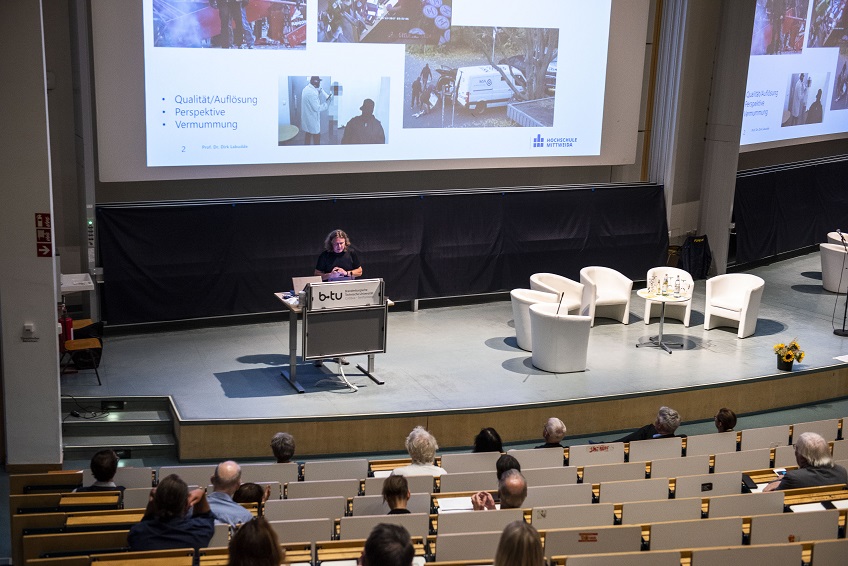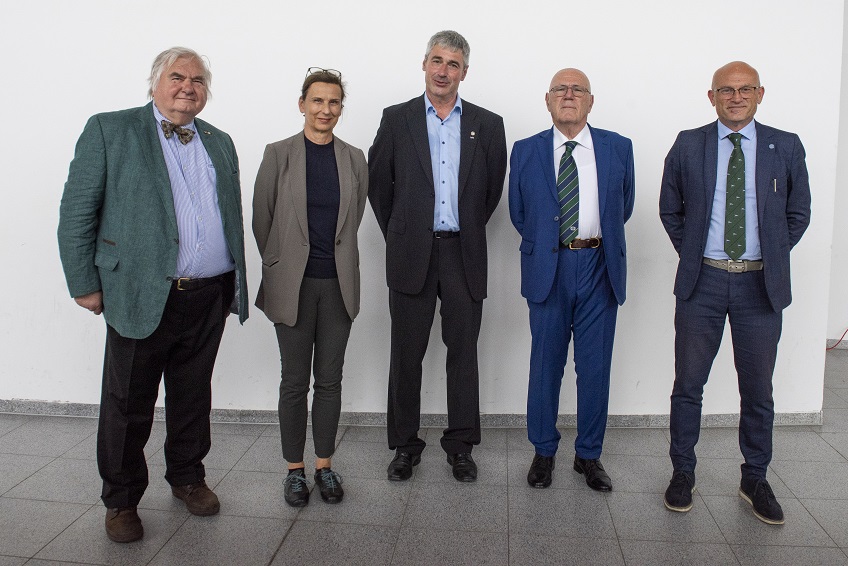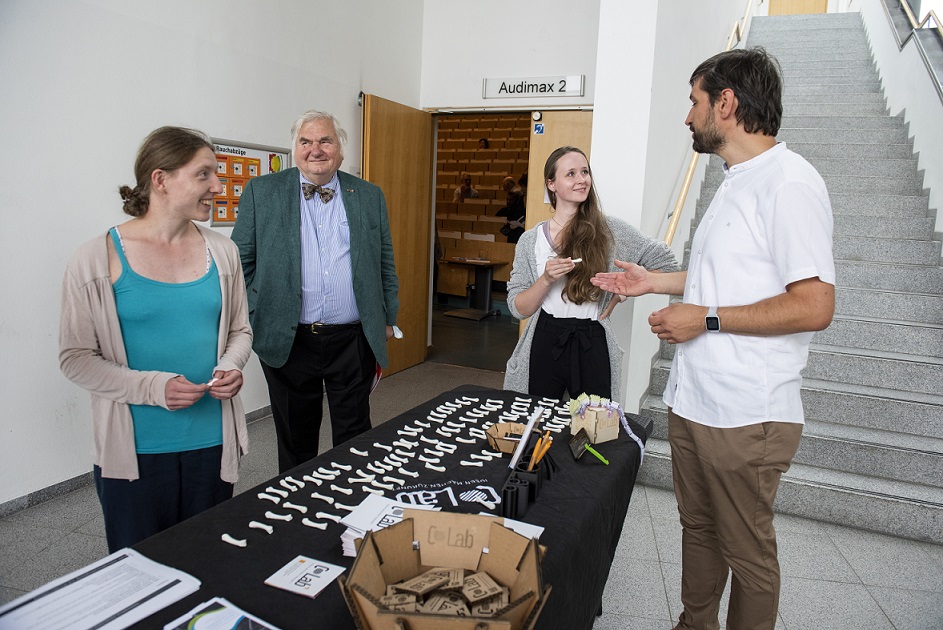Ten years of "Forensic Sciences and Engineering"
Around 150 guests, companions and friends took part in the celebratory event at the Cottbus Central Campus on 1 July 2022. The president of the BTU, Prof. Gesine Grande, opened the event and pointed out the unique position of the continuing education programme "Forensic Sciences and Engineering", both in Germany and within the BTU. She described it as a "flagship" for the university location in Cottbus-Senftenberg. Suzi Cue - Business and Communication, Cottbus - took over the entertainment and moderation with musical interludes and professional introductions of the respective lecturers. In addition, seven lecturers from the first hour of the course were bid farewell. Among them was the well-known criminologist and explosives expert Prof. Wolfgang Spyra, who also headed the Chair of Contaminated Sites at the BTU for many years. The programme also thanked Dr Wolfgang Wiehe, Dr Bernhard Opitz, Rainer Bote, Dieter Knobelauch, the retired senior public prosecutor Bernhard Brocher and Dr Wolfgang Mattig for their many years of dedicated work in the Forensic Sciences and Engineering (M.Sc.) programme.
The degree programme was established ten years ago as the result of a European joint project with partner universities in Cottbus, Messina, Budapest and Parma. Prof. Giovanni Mori, now retired, and Dr. Alexandro Bernazzoli, today head of the International Office of the University of Parma, travelled from the lead university in Parma, Italy, as guests of honour. Currently, the degree programme is offered exclusively in Cottbus. Prof. Mori, who can be described as the grandfather of the degree programme, expressed his pleasure and appreciation for its development at the BTU.
The core of the event was a total of four lectures. Prof. Dirk Labudde from Mittweida University of Applied Sciences reported on the successful presentation and introduction of a new forensic method in court. Specifically, it is about the digital representation of persons on camera recordings, which can be transferred as a court-proof forensic fact on the basis of the so-called "rig" (= virtual skeleton in animation technology), via which the individualised course of movement of a person's skeleton is depicted in the form of a digital twin. In this way, the LKA Berlin succeeded in excluding at least some persons from the circle of suspects in the gold coin robbery at the Bode Museum, while in other proceedings this technology even succeeded in convicting perpetrators.
Prof. Wolfgang Spyra summed up the situation of the study programme, which will be reorganised in the next two years, to the extent that he explained the options of cooperation with the police forces of the Länder and the university's institutions.
He also shed light on the circle of prospective students and graduates and named insurance companies, banks, customs and technology companies as possible cooperation partners in addition to the investigative authorities. He used examples from Switzerland to illustrate how cooperation can succeed, referring to Prof. Margot from the University of Lausanne and Dr. Pfefferli from the Zurich Cantonal Police.
This common starting point was also apparent in the presentations by Apl. Prof. Thomas Fischer and PD Dr. Stefan Rödiger. Prof. Fischer, head of the BTU's Central Analytical Laboratory (ZAL), used clips from well-known CSI series to show how certain issues are presented on television or in streaming services. He compared this with his approach and working method. In addition, he presented current research results and publications that he and his team had achieved in the context of their forensic research foci of script evaluation and entomology. The result was that although the presentations on television were sometimes abbreviated and did not always favour the best method, they were not completely wrong either. Together with PD Dr. Rödiger, this team convinced with a depth of forensic considerations with connecting points to the topics of bioinformatics and digital forensics.
Representing the former chief forensic physician in Brandenburg, Dr. Wolfgang Mattig, who was ill, Dr. Hartmut Fischer, also from the Institute of Forensic Medicine in Potsdam, explained that autopsies and further examinations by forensic medicine not only complement forensic examinations, but also make a significant contribution to the clarification of cases of capital crimes, but also other crimes. Especially in cases where the cause of death is unclear, the use of forensic medicine is absolutely necessary in order to be able to determine whether a crime has been committed or not.
Between the lectures, the question of crime scene work and corresponding forensic assessment was discussed on the basis of two short inserts from a well-known police training video. In the end, the assessments and statements of criminologists such as Rainer Bote, formerly of the Hamburg Criminal Investigation Department, and the former head of forensic technology at the Brandenburg LKA in Eberswalde Dieter Knobelauch, of forensic experts such as Prof. Spyra and Dr. Hartmut Fischer, the public prosecutor's office, represented by senior public prosecutor Jessica Hansen and the former head of the public prosecutor's office in Cottbus, retired senior public prosecutor Berhard Brocher came to the conclusion that the be-all and end-all of later investigative success is the clean, meticulous and comprehensive securing of evidence during the initial attack.
Course director Prof. Eike Albrecht and coordinator Dirk Marx, MBL, thanked all the lecturers, especially those who were leaving after ten years of teaching in the Forensic Scienecs and Engineering (M.Sc.) course, for their tireless and reliable imparting of specialist knowledge with a bouquet of flowers and Spreewald bitters, against the pain of parting. In the garden in front of the quasiMono, the festive finale took place in a smaller setting. This gave the students of this year's class the opportunity to talk to those of tomorrow and from previous years. In any case, it can be said that the forensic scene meets in Cottbus, and this should continue in the future.



